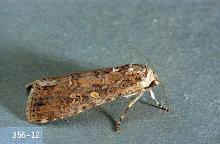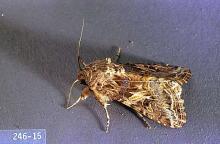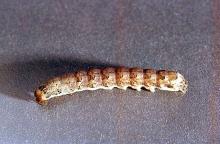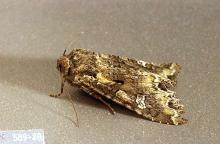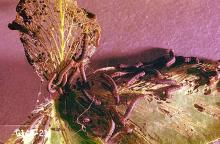Includes
Beet armyworm (Spodoptera exigua)
Bertha armyworm (Mamestra configurata)
Western yellowstriped armyworm (Spodoptera praefica)
Pest description and crop damage Armyworms occasionally are severe defoliators, especially in western Idaho. Damage appears as skeletonized leaves with only leaf veins and petioles remaining. Armyworms are related closely to cutworms but generally are slightly larger, more brightly colored, and actively feed on plants during the day. When infestations become dense and crowded, larvae migrate in groups from field to field; sugar beets adjoining infested alfalfa hay fields or cereals may be completely defoliated by migrating armyworms.
Beet armyworms are dull green caterpillars with a dark, broad stripe along each side and many smaller, light wavy lines down the back. They are about 1.25 inches long when mature.
Bertha armyworms are highly variable, from light yellow-green to gray-black, with a yellow-orange stripe along the side that divides the caterpillar body into a dark upper half and a pale bottom half. They are about 1.25 inches long when mature.
Western yellowstriped armyworms have wide, velvety black stripes along the back with many narrower, bright yellow stripes along the sides. They are about 1.5 inches long when mature.
Scouting and thresholds No formal economic thresholds exist for armyworm insecticide treatment decisions in sugar beets. Consider insecticide application if field scouting shows that infestations average one armyworm larva per plant early in the season. Older plants can tolerate considerable defoliation without any economic loss of root yield or sucrose content.
Management-biological control
Armyworms commonly are attacked by parasitic wasps and flies that can help keep infestations in check. We do not yet know enough about arthropod natural enemies to suggest practical ways of manipulating and enhancing their effects other than avoiding any unnecessary insecticide applications. See Table 3 for commercially formulated biological products.
Management-chemical control
Only post-emergence options are available (Tables 2-3).

